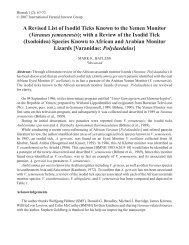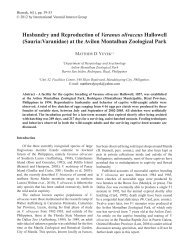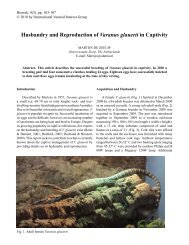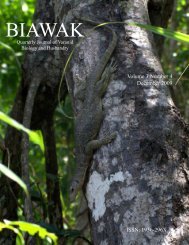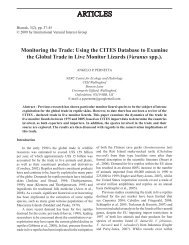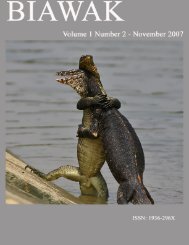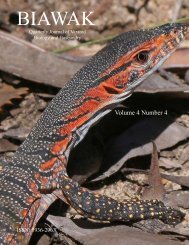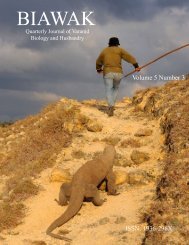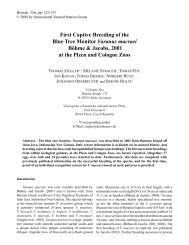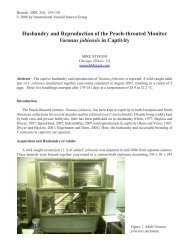Monitor - International Varanid Interest Group
Monitor - International Varanid Interest Group
Monitor - International Varanid Interest Group
- No tags were found...
You also want an ePaper? Increase the reach of your titles
YUMPU automatically turns print PDFs into web optimized ePapers that Google loves.
97BIAWAK VOL. 6 NO. 2Kwet, A. 2012. Die hundertjährigen drachen vonKomodo. Elaphe 20(1): 107-111.Laver, R.J., D. Purwandana, A. Ariefiandy, J.Imansyah, D. Forsyth, C. Ciofi & T.S. Jessop.2012. Life-history and spatial determinantsof somatic growth dynamics in Komodo dragonpopulations. PLoS One 7(9): e45398.Mendyk, R.W., A.L. Newton & M. Baumer. 2012. Aretrospective study of mortality in varanid lizards(Reptilia:Squamata:<strong>Varanid</strong>ae) at the Bronx Zoo:Implications for husbandry and reproductivemanagement in zoos. Zoo Biology. DOI 10.1002/zoo.21043Merchant, M., D. Henry, R. Falconi, B. Muscher & J.Bryja. 2012. Characterization of serumcomplement activity in serum of the Komododragon (Varanus komodoensis). Advances inBiological Chemistry 2: 353-359.Montuelle, S.J., A. Herrel, P.-A. Libourel, S. Daillie &V.L. Bels. 2012. Prey capture in lizards:Differences in jaw-neck-forelimb coordination.Biological Journal of the Linnean Society 105:607-622.Pianka, E.R. 2012. Can humans share spaceship earth?Amphibian and Reptile Conservation 6(1): 1-24.Řeháková-Petrů, M., L. Peške & T. Daněk. 2012.Predation on a wild Philippine tarsier (Tarsiussyrichta). Acta Ethologica 15(2): 217-220.Ridzwan, B.H. & K.S. Fatimah. 2012. Antinociceptiveeffects of crude fats from Egyptian spiny-tailed(Uromastyx aegyptia microlepis) and local monitor(Varanus salvator) lizards. European Journal ofScientific Research 87(2): 236-243.Schmida, G. 2012. The Australian Goanna Pictorial.Self published e-book. 100 p.Schmida, G. 2012. The Goannas of Australia – 2. Selfpublished e-book. 106 p.Sourav, M.S.H., S.U. Chowdhury & S.C. Rahman.2012. Varanus salvator (Water monitor lizard).Bangladesh: Dhaka Division. HerpetologicalReview 43(4): 619-620.Subramanean, J. & M.V. Reddy. 2012. <strong>Monitor</strong> lizardsand geckos used in traditional medicine faceextinction and need protection. Current Science102(9): 1248-1249.Somma, M. & A. Koch. 2012. New morphological anddistributional data of Varanus rainerguentheriZiegler, Böhme & Schmitz, 2007 (Squamata:<strong>Varanid</strong>ae), an endemic and little-known monitorlizard species of the Moluccas, Indonesia.Salamandra 48: 207-212.Ujvari, B., H.-C. Mun, A.D. Conigrave, A. Bray, J.Osterkamp, P. Halling & T. Madsen. 2012.Isolation breeds naivety: Island living robsAustralian varanid lizards of toad-toxin immunityvia four-base-pair mutation. Evolution. DOI:10.1111/j.1558-5646.2012.01751.x.Uyeda, L.T., E. Iskandar, R.C. Kyes & A.J. Wirsing.2012. Proposed research on home ranges andresource use of the water monitor lizard, Varanussalvator. The Forestry Chronicle 88(5): 542-546.van Kempen, C.P. B. 2012. A kerangas forest floor(2011). Herpetological Review 43(2): 224-225.Vidal, N., J. Marin, J. Sassi, F.U. Battistuzi, S.Donnellan, A.J. Fitch, B.G. Fry, F.J. Vonk, R.C.Rodriguez de la Vega, A. Couloux & S.B. Hedges.2012. Molecular evidence for Asian origin ofmonitor lizards followed by tertiary dispersals toAfrica and Australasia. Biology Letters 8(5): 853-855.Welton, L.J., C.D. Siler, A.C. Diesmos, M.L.L.Diesmos, R.D. Lagat, R.M. Causaren & R.M.Brown. 2012. Genetic identity, geographic ranges,and major distribution records for frugivorousmonitor lizards of Luzon Island, Philippines.Herpetological Review 43(2): 226-230.Woodford, L.P., A. Robley, P. Maloney & J. Reside.2012. The impact of 1080 bait removal by lacemonitors (Varanus varius) on a red fox (Vulpesvulpes) control program. Ecological Management& Restoration. DOI: 10.1111/j.1442-8903.2012.00665.xWoodruff, D. 2012. Tree monitor success: A UK firstbreeding? Practical Reptile Keeping, June: 10-11.Yaap, B., G.D. Paoli, A. Angki, P.L. Wells, D. Wahyudi& M. Auliya. 20120 First record of the Borneoearless monitor Lanthanotus borneensis(Steindachner, 1877) (Reptilia: Lanthanotidae) inWest Kalimantan (Indonesian Borneo). Journal ofThreatened Taxa 4(11): 3067-3074.



